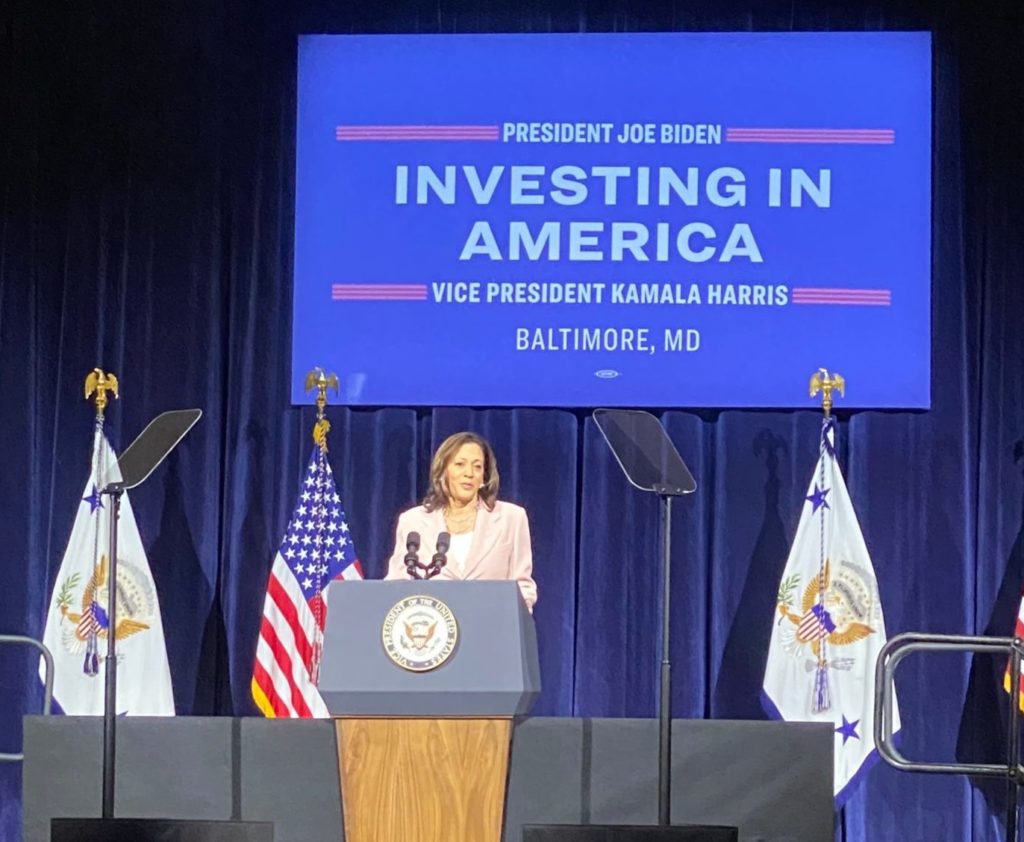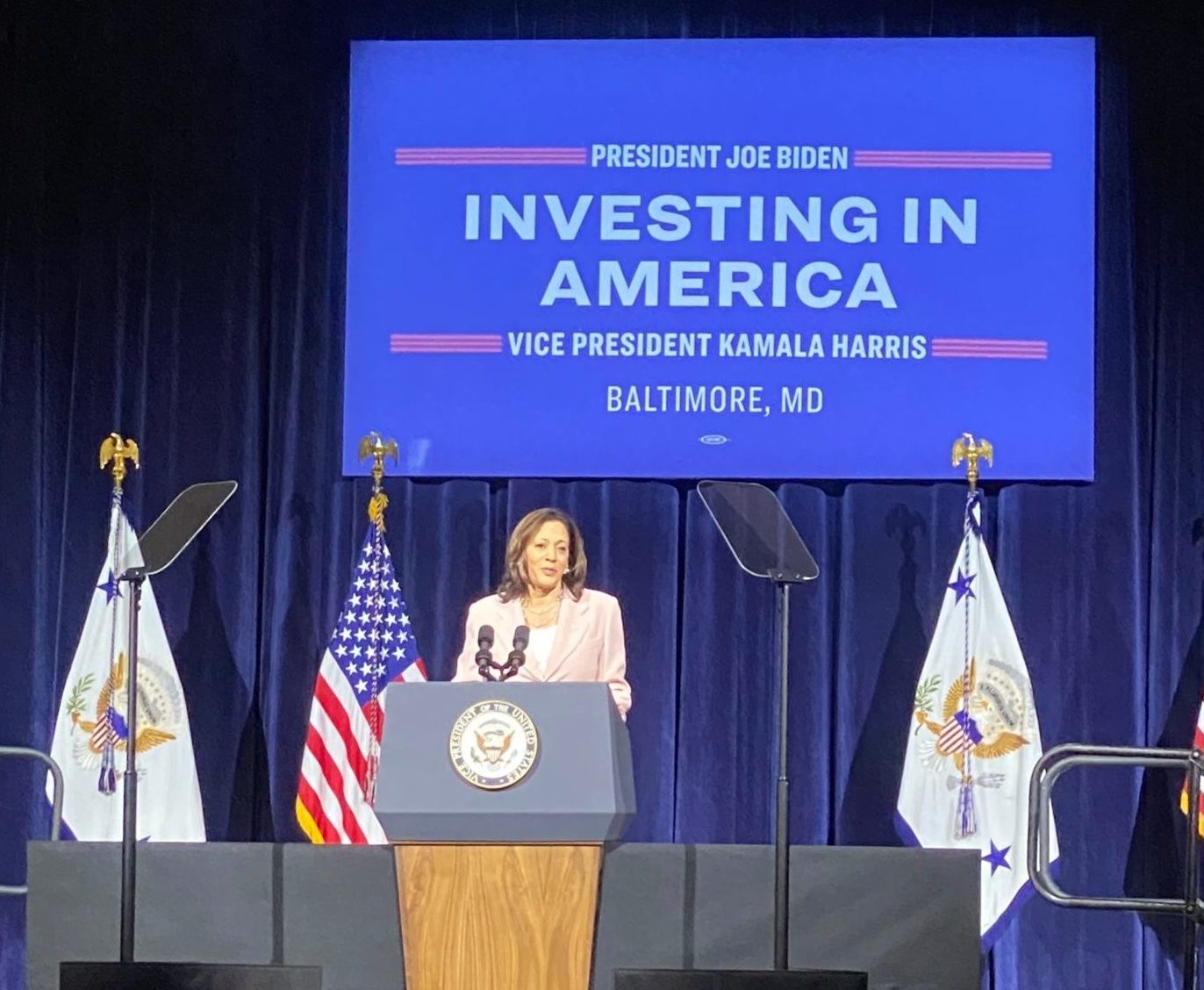
On Friday, July 14, 2023, Just Solutions was invited to join Vice President Harris in Baltimore, Maryland as she delivered remarks highlighting provisions in the Inflation Reduction Act. Joined by EPA Administrator Michael Regan at Coppin State University, they announced $20 billion to capitalize investment in a clean energy financing network and projects in disadvantaged communities across the nation.
“For years, the people of the community — folks who know what their neighborhood needs and how to provide it — have not been given adequate resources to implement climate solutions that match the magnitude of the crisis we face. And that’s why we’re here today. Today, I am proud to announce the largest investment in financing for community-based climate projects in our nation’s history”
Vice President Kamala Harris
It is important to note that this funding is part of the EPA’s $27 billion Greenhouse Gas Reduction Fund, an investment made through the Inflation Reduction Act. This fund will provide competitive grants to finance clean energy and climate projects that reduce greenhouse gas emissions. According to the White House Factsheet, the $27 billion is separated into three competitions:
- The $14 billion National Clean Investment Fund (NCIF) competition is said to provide grants to support two-to-three national clean financing institutions that will partner with the private sector to provide accessible, affordable financing for tens of thousands of clean technology projects nationwide. At least 40% of NCIF funds will flow to low-income and disadvantaged communities, including communities with environmental justice concerns, traditional energy communities, rural communities, Tribal communities, and other underserved areas.
- The $6 billion Clean Communities Investment Accelerator (CCIA) competition is said to work in tandem with the NCIF by providing grants to support two-to-seven hub nonprofit organizations that will provide funding and technical assistance to community lenders working to finance clean technology projects – from retrofitting homes to be highly efficient and zero emissions to electrifying small businesses’ delivery fleets – in low-income and disadvantaged communities. All CCIA funds will flow to these communities, helping advance the Biden-Harris Administration’s commitment to environmental justice.
- The remaining $7 billion for the “Solar for All” competition is meant to increase access to affordable, resilient, and clean solar energy for low-income households. Applications are due October 12, 2023. More information on the three notices of funding opportunities (NOFOs) can be found below.
This announcement was made on the final day of the administration’s Investing in America tour. The event included several speakers welcoming Vice President Kamala Harris to Baltimore including Anthony Jenkins, President of Coppin State University, an HBCU in Baltimore, followed by Brooke E. Lierman, Comptroller of Maryland, and Brandon Scott, Mayor of Baltimore. Speakers also included Congressman Frank Pallone (NJ-06), Senator Edward Markey (MA), Senator Tom Carper (DE), and Senator Chris Van Hollen (MD).
“With the launch of the Greenhouse Gas Reduction Fund, we are deploying powerful tools to help us address climate change through innovative new solutions while creating jobs and growing our economy. These funds will serve as a force multiplier for private investment in clean energy projects to cut emissions and promote environmental justice in underserved communities across the country. This is a win for workers, our economy, and our fight to confront the climate crisis.”
Senator Chris Van Hollen (MD)
Michael Regan, EPA Administrator embraced this moment to emphasize the program’s importance to everyday people, “No matter where you live, you’ll have access to pollution-reducing and cost-saving technologies…this is real money for real people.” Vernice Miller-Travis, Co-Founder of the We Act for Environmental Justice shared remarks on the importance of this movement, “we have not seen this in our lifetimes. We may not see it again. So we have to lean in and meet this moment”. Before introducing Vice President Kamala Harris, she shared additional efforts made by the administration which has launched several initiatives focused on maximizing resources that are integral for community leaders. Vernice shared, “The Vice President has placed a particular focus on community banks such as community development, finance institutions, community financial institutions that give money directly at the community level.”
Vice President Kamala Harris began her speech by sharing her eagerness to make the historic announcement and thanking community leaders like Vernice for their leadership in this work, referencing, “I stand here on the shoulders of people like Vernice” in addition to thanking people in the audience, in particular, the students, the activists, the union workers, and the elected officials present for taking on what she called “one of the most urgent matters of our time: this climate crisis”.
Having met with various stakeholders across the country about the climate crisis, it was clear to them that many climate advocates do not have access to the funds or have not been given the resources to implement climate solutions. She shared, “For years, one of the missing pieces in our strategy to fight the climate crisis is that we have not invested at scale in community climate action.”
Harris acknowledges that what makes this funding significant is that we have not seen an investment of this magnitude in climate efforts in years. Therefore, “by dramatically accelerating our work, we know we can lower emissions. And we will do that by providing $20 billion to a national network of nonprofits, community lenders, and other financial institutions to fund tens of thousands of climate and clean energy projects across America”. Having set a goal to cut greenhouse gas emissions in half by 2030 and to reach net zero emissions by 2050, the investment announced by Vice President Harris is meant to help achieve these goals.
Harris put a special focus on communities that have been historically left out and left behind. “The least, in terms of where investments have been made in mitigation and adaptation; the hardest hit and the least able to recover. So to address this inequity, nearly $12 billion of this funding we’re announcing today will be invested in overlooked communities.” In addition, she equally placed focus on the role of community banks as the “fastest and most effective way to get the resources to the community”, emphasizing that their community-centered approach is “the kind of vehicle we need to think about how we get these billions of dollars to the people who know what to do with it.” Due to their unique role, they ensured that community banks are eligible for the funding.
Our work, Our Impact

Over the last two years, Just Solutions has led and contributed to multiple efforts to ensure equity in federal funding. As the “single largest investment in clean energy, environmental justice, and carbon pollution reduction in American history,” Just Solutions, in collaboration with various partners, has researched what the impacts and opportunities are for environmental justice communities. This includes but is not limited to the following research, recommendations/best practices, educational programming, and collaborations::
- Just Solutions sent a letter to EPA requesting that they release more program details on the Greenhouse Gas Reduction Fund, endorsed by over 60 organizations. EPA then released the Implementation Framework, which provided more information about the GGRF before the notice of funding opportunities (NOFOs) came out.
- “What you need to know about the Greenhouse Gas Reduction Fund” Webinar (recording). The Climate & Clean Energy Equity Fund and Just Solutions hosted a webinar to explore what we know about the EPA’s Greenhouse Gas Reduction Fund, and how organizations and nonprofits can participate and prepare for the $27 billion in funds for environmental justice communities.
- Greenhouse Gas Reduction Fund: Best Practices for Equity and Governance Article highlights the huge opportunity to advance environmental justice, but only if it is implemented appropriately. This article shares highlights on EPA’s implementation framework for the program as well as an overview of best practices for equity and governance. These best practices are endorsed by over 60 organizations and support from CDFI applicants.
- Home Energy Rebates and the IRA: Recommendations for Equity and Environmental Justice Article. The home energy rebates are the Department Of Energy (DOE) programs that state energy offices will implement. There are two: one is for electrification and the other is for whole-home energy efficiency. Just Solutions has asked for a 40% set-aside for LI/DACs and an additional set-aside for multifamily affordable housing. This article provides a summary of our recommendations and a full comment letter can be found here.
- Energy Research Collaborative. Just Solutions is convening several environmental justice and community-based organizations from around the country to create a framework to evaluate technologies, specifically the hydrogen hubs program and Long Duration Energy Storage program, both from IIJA.
To join our newsletter please sign up here for highlights, updates, and opportunities delivered directly to your inbox
EPA Greenhouse Gas Reduction Fund Competitions (Applications)
- National Clean Investment Fund: The deadline to apply to this grant competition is October 12, 2023. EPA intends to make two-to-three awards under this competition. Applicants must be eligible nonprofits as defined in Section 134(c)(1) of the Clean Air Act and as further explained in the NOFO. Coalitions, led by an eligible nonprofit, are also eligible to apply to this competition. Additional details on eligibility can be found in Section III of the NOFO.
- Clean Communities Investment Accelerator: The deadline to apply to this grant competition is October 12, 2023. EPA intends to make two-to-seven awards under this competition. Applicants must be eligible nonprofits as defined in Section 134(c)(1) of the Clean Air Act and as further explained in the NOFO. Coalitions, led by an eligible nonprofit, are also eligible to apply to this competition. Additional details on eligibility can be found in Section III of the NOFO.
More information can be found on EPA’s GGRF webpage. Read the full announcements for both programs here and here.
